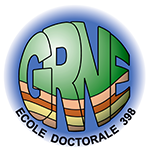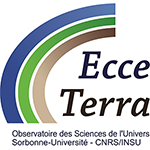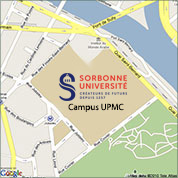Séminaire ISTeP - Arthur Paté
Un essai de "psychosismologie" : comment la perception de séismes sonifiés peut-elle aider la sismologie ?
Recordings of the Earth's surface oscillation as a function of time (seismograms) can be sonified by accelerating time so that most of the signal's frequency spectrum falls in the audible range. The pattern-recognition capabilities of the human auditory system can so be applied to the auditory analysis of seismic data. We sonify a set of seismograms associated to a magnitude 5.6 Oklahoma earthquake recorded at 17 broadband stations within a radius of ~300km from the epicenter. A group of volunteers listen to our sonified seismic data set via headphones, a sound card, a laptop computer, and software allowing them to reproduce each signal as many times as they want, while shifting the corresponding icon on the screen. Following the "free categorization" approach, listeners are asked to group icons corresponding to sounds that they perceive as "similar." Instructions are deliberately vague, as this is the first experiment of this kind, and no correlation has ever been established between physical parameters defining a seismogram, and the perceived properties of the corresponding sonified signal. Less than half of the listeners have an Earth sciences background, and most of them have never heard a sonified seismogram. The results of our experiment indicate that listeners perceive some relevant "clues" in the stimuli, and attempt to group them accordingly. We have been able to identify two categorization strategies, each followed by several listeners, which suggests that auditory analysis of seismic data is feasible and possibly useful. Yet, it is hard to associate perceived groups to any geological or seismological parameter. Our preliminary findings encourage further work, where we plan to focus on more specific tasks, make use of synthetic rather than real-world signals, and take advantage of recent progress in auditory scene synthesis algorithms and spatial audio technology.
20/02/2015 à 12h30, Salle Fourcade (Tour 55/56, 4ème étage)
Egalement dans la rubrique
- Séminaire ISTeP - Chrystèle Sanloup
- Séminaire ISTeP - Marco Scambelluri
- Séminaire ISTeP - Déborah Chavrit
- Séminaire ISTeP - Evgueni Burov
- Séminaire ISTeP - Anne Le Friant
- Séminaire ISTeP - Pierre Valla
- Séminaire ISTeP - Ramadan Ghalayini
- Séminaire ISTeP - Matthias Delescluse
- Séminaire ISTeP - Séverine Moune
- Séminaire ISTeP - Lucie Tajcmanova
- Séminaire ISTeP - Gabriel Coelho
- Séminaire ISTeP - Laurie Bougeois
- Séminaire ISTeP - Jacques Touret
- Séminaire ISTeP - Sanae El Janyani
- Séminaire ISTeP - Nicolas Beaudoin
- Séminaire ISTeP - Kosuke Ueda
- Séminaire ISTeP - Ali Hannouche
- Séminaire ISTeP - Benjamin Cochain
- Séminaire ISTeP - Behzad Nasri
- Séminaire ISTeP - Daniel Pastor Galan
- Séminaire ISTeP - Sara Lafuerza Colas
- Séminaire ISTeP - Jean-Pierre Suc
- Séminaire ISTeP - Pierpaolo Zuddas
- Séminaire ISTeP - Agnès Elmaleh
- Séminaire ISTeP - John Wakabayashi
- Séminaire ISTeP - Jonas Ruh
- Séminaire ISTeP - Timm John
Chiffres clés (Mars 2025)
L'ISTeP comprend 131 membres dont :
Permanents (66)
- Professeurs : 17 (+2 PAST)
- Maîtres de conférence : 26
- Directeurs de recherche CNRS : 1
- Chargés de recherche CNRS : 1
- ITA : 19
Personnels non permanents (65)
- Collaborateurs bénévoles / émérites : 17
- Chaire de professeur junior : 1
- Enseignants-chercheurs contractuel : 2
- 1 MCF accueil en délégation
- ATER et Post-Docs : 9
- Doctorants : 32
- ITA-BIATSS : 3





